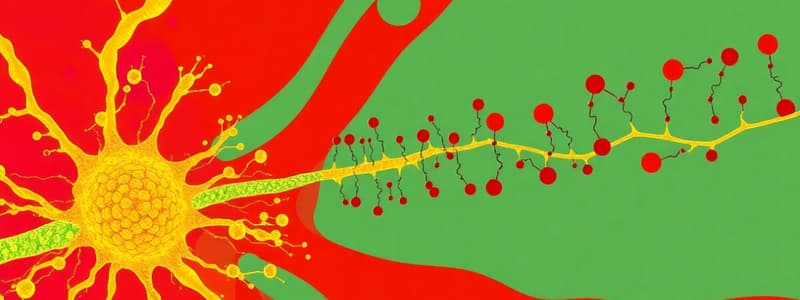Podcast
Questions and Answers
What is the primary function of DMRT transcription factors?
What is the primary function of DMRT transcription factors?
- Facilitating protein synthesis
- Influencing gonadal development and maintenance of sex-specific traits (correct)
- Controlling cellular respiration
- Regulation of metabolic pathways
Which of the following organisms is NOT known to possess DMRT genes?
Which of the following organisms is NOT known to possess DMRT genes?
- Drosophila (fruit flies)
- Mice
- Caenorhabditis elegans (nematodes)
- Escherichia coli (bacteria) (correct)
What is a potential consequence of mutations in DMRT genes?
What is a potential consequence of mutations in DMRT genes?
- Improved reproductive capacity
- Induction of sex reversal or intersex conditions (correct)
- Enhanced metabolic efficiency
- Increased resistance to diseases
Which of the following statements about DMRT genes is true?
Which of the following statements about DMRT genes is true?
What key feature characterizes the DMRT gene family?
What key feature characterizes the DMRT gene family?
Flashcards are hidden until you start studying
Study Notes
DMRT (Doublesex and Mab-3 Related Transcription Factors)
-
Definition: DMRT refers to a family of transcription factors involved in sexual differentiation and development in various organisms.
-
Gene Structure:
- The DMRT gene family is characterized by the DM domain, which is essential for DNA binding and interaction with other proteins.
- Typically includes several conserved motifs that are important for their function.
-
Function:
- Plays a crucial role in the regulation of genes involved in sex determination and differentiation.
- Influences gonadal development and maintenance of sex-specific traits.
-
Organisms:
- Found in a wide range of species, including:
- Humans
- Mice
- Drosophila (fruit flies)
- Caenorhabditis elegans (nematodes)
- Various fish and amphibians.
- Found in a wide range of species, including:
-
Sexual Development:
- In some species, DMRT genes are implicated in male sex determination.
- Mutations or disruptions in DMRT can lead to sex reversal or intersex conditions.
-
Evolutionary Aspect:
- DMRT genes are believed to have evolved from a common ancestor and have diversified across different lineages.
- The study of DMRT provides insights into the evolution of sexual development mechanisms.
-
Research Applications:
- Used in understanding disorders of sex development (DSDs).
- Potential applications in agriculture for controlling sex in fish and other species for breeding purposes.
-
Key Members:
- DMRT1: Most studied in mammals, critical for male sex determination.
- DMRT2, DMRT3: Involved in various developmental processes and have different roles across species.
-
Clinical Relevance:
- Mutations in DMRT genes are associated with certain types of infertility and congenital conditions related to sexual development.
Definition
- DMRT represents a family of transcription factors crucial for sexual differentiation and development across diverse organisms.
Gene Structure
- Characterized by the DM domain, essential for DNA binding and protein interactions.
- Contains several conserved motifs that support their functional roles.
Function
- Regulates genes responsible for sex determination and differentiation.
- Influences gonadal development and the maintenance of sex-specific traits.
Organisms
- Present in a wide array of species including:
- Humans
- Mice
- Drosophila (fruit flies)
- Caenorhabditis elegans (nematodes)
- Various fish and amphibians.
Sexual Development
- In certain species, DMRT genes are linked to male sex determination.
- Mutations or disruptions can cause sex reversal or intersex conditions.
Evolutionary Aspect
- DMRT genes likely evolved from a common ancestor, diversifying across different lineages.
- The study of these genes enhances the understanding of sexual development evolution.
Research Applications
- Employed in investigating disorders of sex development (DSDs).
- Potential agricultural applications for managing sex in fish and other species to optimize breeding.
Key Members
- DMRT1: The most researched, vital for male sex determination in mammals.
- DMRT2 and DMRT3: Participate in various developmental processes with distinct roles in different species.
Clinical Relevance
- Mutations in DMRT genes are linked to specific infertility types and congenital conditions associated with sexual development.
Studying That Suits You
Use AI to generate personalized quizzes and flashcards to suit your learning preferences.
